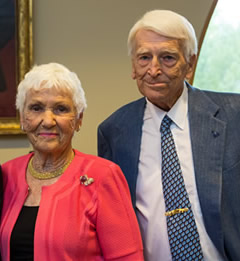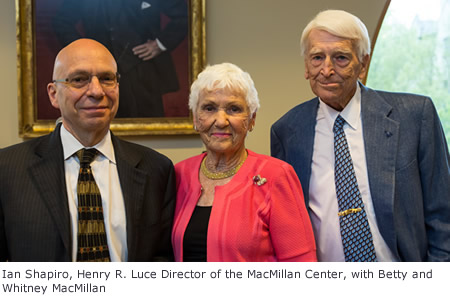

On April 28, the MacMillan Center organized two panel discussions to mark the 10th anniversary of the naming of the Center. The first panel on “Refugees, Forced Displacement, and Humanitarian Response” was moderated by Ian Shapiro, Henry R. Luce Director of the MacMillan Center, and Sterling Professor of Political Science.
First panelist, Jason Lyall, Associate Professor of Political Science, spoke of the two projects he is involved in Afghanistan, connected with the Political Violence Field Lab at the MacMillan Center. The first project under the auspices of the USAID tried to evaluate the impact of humanitarian assistance in the aftermath of civilian casualties in the period between 2011 and 2013. To ascertain if the aid was successful, the counter-intuitive and counter-productive finding of the study was that in some of the areas the support for the Taliban went up, rather than going down, as a result of the humanitarian assistance. The second on-going project in Kandahar province tries to find out if offering vocational and skills training to 3,000 refugees by the Mercy Corps has been able to blunt the Taliban recruitment effort in the camps or if it is a “fool’s errand.”
Moshfiq Mobarak, Professor of Economics, said that at macro level there are inequalities between countries, but there is inequality within countries, too, and that is often because poor people are stuck in very unproductive areas. In developing countries, the productivity gap between urban and rural areas is about 3 to 1. Most often there is no explicit restriction, but government policy is designed to keep people in the wrong places. Mobarak organized a randomized control trial in which rural people were given an incentive to move to urban areas to try living and working there for a period. In a trial in Bangladesh, the family of a farmer who moved to city during lean season was seen to consume 600 calories more per person per day. The conclusion from the experiment is that “the best developmental intervention we can do is to allow people to move around. Economists and policy-makers call for free movement of capital and goods, he said, but seek to put restrictions on movement of other factors of production – people.”
Catherine Panter-Brick, Professor of Anthropology, noted three key facts about the refugee situation. In 2015, a record number of people have been displaced – one out of 122 human beings, a majority of them from war-torn Syria. Secondly, over half of the refugees are in urban areas and not in camps, and the average level of displacement is 10 years, which means one needs to address their long terms need such as the right to work. The third key factor is that half of the refugees are children under the age of 18 and that requires addressing their developing minds and aspirations. In the past six months, Panter-Brick has been working with a humanitarian organization that delivers programs to Syrian refugees located in northern Jordan. A program called “No Lost Generation” for refugees of 13 to 17 years old is trying to alleviate their stress and distress as well as give them life skills that will put them in a good place for building a future. Since there is little data on what works and what does not, her job involves trying to do a better scientific job in collecting data. Another program involves working with humanitarian organizations and diplomats to build a culture of peace among young children in conflict countries of Africa.
Margaret Peters, Assistant Professor of Political Science, noted that compared to the past when, for instance, one million Irish migrants affected by the Irish Great Famine moved to the United States and 200,000 to Britain, borders have become more restricted. Syrian refugees who have moved to Turkey and Jordan are moving illegally in the hope of finding asylum in European countries. In researching her book project, Peters found that the ability of capital to move has changed the incentive to open immigration. The supporters of open immigration have not been humanitarians but business. Now instead of bringing immigrants to the United States, business has just moved to China. And when they moved to China they no longer support open immigration. Another project on the politics of migration that Peters is about to begin is a major field survey of refugees from Afghanistan, Iraq, Syria, and other countries trying to understand the reasons for their move – Wars have been going on for some time, but why does suddenly everybody wanted to move? Where do they want to go and why? What do the refugees think the world owes them? In looking at other surveys, Peters has found that letting migrants come to a democratic country helps democratize their own countries.
Following the panelists remarks, Ian Shapiro quoted Nobel laureate Amartya Sen, who said democracies deal with famine well because that is a crisis but not with poverty as it is a chronic problem, and asked whether one needs to take advantage of the fact that chronic refugee problems have mushroomed into a crisis to address fundamental questions. Mushfiq Mobarak agreed that it is a strategic moment to take advantage of interests in refugee issues to think systematically and push for some intervention.
The second panel on “Global Debt: Challenges for Political Governance and Financial Stability” was moderated by Ernesto Zedillo, Professor in the Field of International Economics and Politics; Frederick Iseman ’74 Director, Yale Center for the Study of Globalization; and former President of Mexico (1994-2000).
Introducing the panel theme, Professor Zedillo said, “Although the Great Depression that one feared did not happen, the recovery has been slow.” Global debt to GDP ratio has continued to grow since the subprime crisis. He noted that this is worrisome because we should have digested the episode of the crisis by now. China is slowing down and its debt to GDP has quadrupled. The countries that were considered engines of global growth, such as Brazil, have contracted. “We cannot envisage how this vicious cycle of lack of demand, weak growth, and increasing indebtedness is going to be stopped,” Zedillo concluded.
Kathryn Dominguez, Professor of Public Policy and Economics at the University of Michigan, noted that since the crisis, countries have been holding of U.S. Securities or Euro denominated bonds. China currently has a reserve of $3.2 trillion, a good part of which is in U.S. dollars. Most emerging countries, and even Switzerland and Japan, have built up foreign reserves. However, since the crisis, Chinese debt has built up, mostly in the private sector, and it is not certain that the Chinese government will bail them out. The countries can also use the reserve to backstop their plan to devalue. Emerging market countries have taken a lesson from the past crisis and built up their reserves as a rainy day fund of sorts. Because of its reserve, built to combat speculative attack, China has done better during the crisis than other emerging countries, but total accumulated global debt now is larger than in 2009. China’s current debt to GDP ratio is close to that of the U.S. and Europe but it is sizably higher than before the crisis and its trajectory is different. The debt is not sovereign debt. It is private sector, non-financial firms that have built up debt. Dominguez concluded that it is not clear how Chinese government will handle the failure of the companies to finance their debt.
Andrew Metrick, Michael H. Jordan Professor of Finance and Management, addressed the question of debt and financial stability. One main result of the large-scale study of debt is that debt predicts financial crisis. Post World War II, there has been a huge financialization of the economy. Financial assets to GDP have gone up from one times GDP in 1952, to four and half times GDP today.
John Geanakoplos, James Tobin Professor of Economics, said that debt has been a part of history, and from Hammurabi to Solon to Julius Caesar, it has been resolved by debt forgiveness. Debt is the engine of growth and also the cause of worst financial crisis. For seven years, the interest rate has been near zero to promote growth. Terms of credit affect prices of assets. Debt overhang is one of the reasons of a languishing economy. Geanakoplos noted that it is astonishing that we did not forgive subprime debt. Not a single penny. Because we hung on, Geanakoplos noted that we got only 40 percent of the debt. Moving on to the dire financial situation in Greece, he noted that its debt to GDP ratio is 200 percent – all owed to foreigners and it has 24 percent unemployment rate and it cannot devalue its currency as it is tied to the Euro. It is unable to repay the debt in this condition but is expected to pay up 3.5 percent of their GDP in 30-40 years. No free country, Geanakoplos said, has paid 3.5 percent of its GDP to foreigners. The IMF has called for forgiving the debt, but EU refuses to agree because is does not want to set a precedent.
